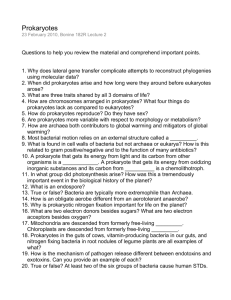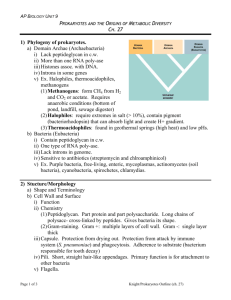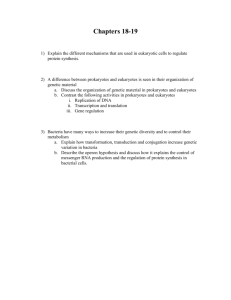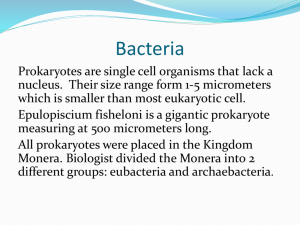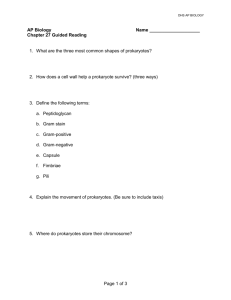bacteria
advertisement
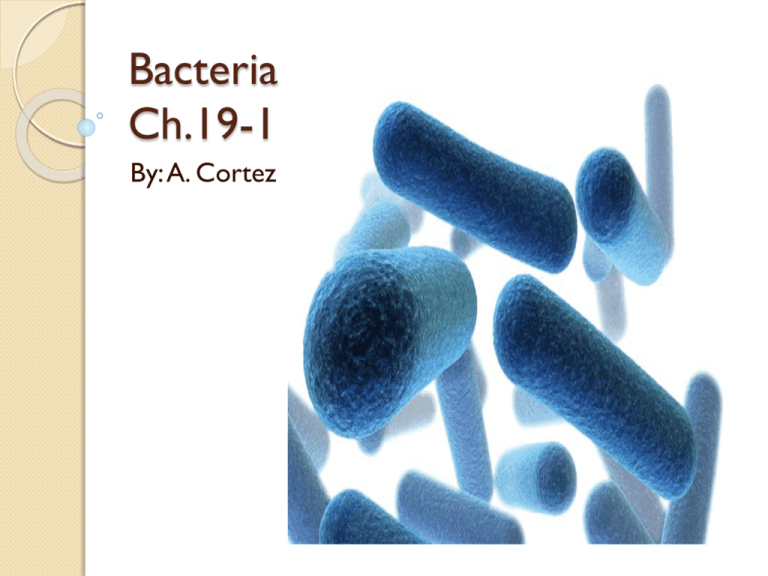
Bacteria Ch.19-1 By: A. Cortez Classifying Prokaryotes Thanks to Robert Hooke and Anton van Leeuwenhoek, the invention of the microscope opened our eyes to the hidden, living world around us. Microscopic life covers nearly every square centimeter of Earth Classifying Prokaryotes Remember!!!!- The smallest and most common microorganisms are Prokaryotes They are single-celled, lack a nucleus For many years prokaryotes were called “bacteria” Classifying Prokaryotes Until most recent prokaryotes were placed in the kingdom-Monera. Now, they are divided into two kingdoms: Eubacteria and Archaebacteria Classifying Prokaryotes Remember they are much smaller then eukaryotic cells. Prokaryotes range about 1 to 5 micrometers Eukaryotes range: 10-100 micrometers in diameter. Classifying Prokaryotes Eubacteria Eubacteria is the larger of the two kingdoms Has a wide range of organisms with different lifestyles. They live mostly everywhere: freshwater, land, salt water, and within the human body. They have a cell wall that protects from injury and the cell wall contains a peptidoglycan which is a source of carbohydrate. Classifying Prokaryotes Archaebacteria Archaebacteria look very similar to eubacteria under microscope. They are both small, lack nucleus, have cell wall, but chemically archaebacteria are quite different. Classifying Prokaryotes Archaebacteria They lack peptidoglycan with eubacteria does have. Also, The DNA sequences of key archaebacterial genes are more like those of eukaryotes. They live in extreme environments such as: volcanos, areas of boiling point waters, the great salt lake in Utah. Identifying Prokaryotes Prokaryotes are identified by characeristics such as shape, the chemical nature of their cell walls, the way they move, and the way they obtain energy. Identifying Prokaryotes Shapes A Rod-shaped prokaryote is called a Bacilli A Spherical prokaryote is called a Cocci Spiral and corkscrew-shape is called a Spirilla Cocci Spirilla Identifying Prokaryotes Identifying Prokaryotes Cell Walls Two types of cell walls Scientist use a method called Gram staining to tell them apart. The gram stain consist of two dyes: violet and red. Identifying Prokaryotes Cell Wall The violet stain is applied first , which stains peptidoglycan cell wall. Then followed by a alcohol treatment that tends to wash out the stain. Gram Positive bacteria has thick peptidoglycan walls that remain dark in color. Gram Negative bacteria has a thinner walls, alcohol dissolves peptidoglycan, light color:pink, light red. Identifying Prokaryotes Movement You can identify prokaryotes by where they move and how they move. They are propelled by flagella, a whiplike structure used for movement Identifying Prokaryotes Movement Other prokaryotes lash, snake, or spiral forward. Also some Prokaryotes glide slowly along a layer of slimelike material they secrete Metabolic Diversity Most prokaryotes are heterotrophs, meaning that they obtain energy by consuming organic molecules made by other organisms. Other prokaryotes are autotrophs and make their own food from inorganic molecules. Two types of Heterotrophs 1. Chemoheterotrophs 2. Photoheterotrophs Metabolic Diversity Most heterotrophic prokaryotes must take in organic molecules for both energy and a supply of carbon, these prokaryotes are called chemoheterotrophs. We are chemoheterotrophs ourselves Which means prokaryotes compete directly with us for food. Metabolic Diversity A smaller group of heterotrophs called photoheterotrophs , use sunlight for energy, but also need organic compounds as a carbon source. Metabolic Diversity There are two types of autotrophs. 1. Photoautotrophs 2. Chemoautotrophs Photoautotrophs-use light energy to convert carbon dioxide and water to carbon compounds and oxygen. Metabolic Diversity Chemoautotrophs- make organic carbon molecules from carbon dioxide They do not require light as a source of energy. Instead they consume chemical reactions from ammonia, hydrogen sulfide, nitrites, sulfur, or iron. Examples: ocean floor plants Metabolic Diversity Releasing Energy Bacteria need a constant supply of energy. Organisms that require a constant supply of oxygen in order to live are called: Obligate Aerobes. Organisms(bacteria) that do not require oxygen and, in fact may be killed by it are called: Obligate Anaerobes. Organisms that can live with or without oxygen are called Facultative Anaerobes Growth and Reproduction Conjugation: Bacteria are able to exchange genetic information A hollow bridge forms between two bacterial cells Growth and Reproduction Binary Fission: When a bacterium has grown so that it has nearly doubled in size, it replicates its DNA and divides in half, producing two identical “daughter” cells. Growth and Reproduction Spore formation: when growth conditions become unfavorable, many bacteria form structures called spores. One type of spore is called endospore A thick internal wall that encloses its DNA and a portion of its cytoplasm. Importance of Bacteria Bacteria are vital to maintaining the living world. Some are producers that capture energy by photosynthesis. Others are decomposers, which break down the nutrients in dead matter and the atmosphere. Importance of Bacteria Decomposers Bacteria help the ecosystem recycle nutrients. Maintaining equilibrium Ex. When a tree dies, bacteria attacks and digests the dead tissue. Breaking it down into simpler tissue, which are released into the soil. Importance of Bacteria Quick reminder !!!!! That Nitrogen (N), gas makes up approximately 80 percent of Earth’s atmosphere. Plants need nitrogen to make amino acids, the building blocks of proteins. However, plants cannot use nitrogen gas directly…………… Importance of Bacteria Nitrogen must be changed chemically to ammonia (NH3) or other nitrogen compounds. This process of converting nitrogen gas into a form plants can use is known as Nitrogen Fixation. Human Uses of Bacteria Bacteria provides us with products we depend on every day. 1. Production of a wide variety of foods and beverages. 2. Digest petroleum to clean oil spills 3. Removal of poison from water. 4. Humans benefit from E.coli , by it making a number of vitamans that body cannot itself.


